Akrotiri
The history of a secret ancient civilization
The history of a secret ancient civilization
The most prominent archaeological site in Santorini -and one of the most important archaeological sites in the Aegean– is Akrotiri and the findings of the excavations that began in 1967.
Akrotiri (Promontory) is located at the southwestern tip of the island, 15 km from Fira. It is a real promontory, with sheer cliff shores stretching three miles west of the southernmost part of Santorini.
After several years, the archaeological site re-opened for the visitors since April 2012, after the new roof was in place.
First signs of habitation in Akrotiri date back to the Late Neolithic Period (at least from the 4th millennium BC). By the Early Bronze Age (3rd millennium BC), there was a settlement in Akrotiri that was expanded in the Middle and Late Bronze Age (20th-17th centuries BC) becoming one of the main urban centres of the Aegean.
Covering about 50 acres, the settlement had a very well-planed infrastructure and an elaborate sewage system. Imported products found inside the buildings prove that Akrotiri was well developed, held strong ties with Minoan Crete and conducted business with the Greek mainland, the Dodecanese, Cyprus, Syria, and Egypt.
The growth of the town ended abruptly at the end of the 17th century BC, when its inhabitants left due to powerful seismic foreshocks. Then, the volcano erupted, and volcanic material covered the town and the rest of the island, preserving the buildings and their contents to this day.
Professor Spyros Marinatos began systematic excavations in Akrotiri, in 1967. He had decided to excavate there in order to prove an old theory of his, i.e. that the eruption of the volcano caused the collapse of the Minoan civilization in Crete (see also Attractions-Volcano).
After Marinatos died, in 1974, excavations continued under the direction of professor Christos Doumas.

A big, at least two-storied, building with 14 rooms on each floor. Many of them are connected with pier-and-door partitions (polythyra) and decorated with frescoes, while there is a “Lustral Basin” in one of them. The most interesting frescoes are the Crocus Collectors, depicting three women in a field of crocus clusters and an altar, as well as the Altar, which depicts women collecting crocus and offering them to a sitting deity, surrounded by an ape and a griffin.
Section Β: It probably includes two separate buildings attached to each other. The frescoes of the Antelopes and the Boxers originated from the floor of the western building. The eastern building is the origin of the fresco of the Apes, a composition with monkeys climbing on rocks at the banks of a river.
The West House: A relatively small, but well-organized edifice. On the ground floor, there are food storage areas, workshops, a kitchen and a mill facility. The first floor has a spacious room where looms, a food and utensils storage area, a toilet and two consecutive walls with frescoes were located. Of these, the one is decorated with the two frescoes of the Fishermen, the fresco of the Priestess and the famous miniature frieze of the Fleet that runs its four walls. The frieze depicts a fleet visiting coastal cities, the last of which identifies with Akrotiri itself. The other space is decorated with the eight frescoes of the Ship Cabins.
Building Complex D: It consists of four buildings. A room of the east edifice was found decorated with the Spring Fresco, which consists of a rocky landscape with blossoming lilies and swallows flying between them. Tablets of Linear A script were found in the same building. All the buildings of Building Complex D gave remarkable mobile finds.
The House of the Ladies: The Ladies and the Papyruses Fresco, to which it owes its name, was found in this building.
This is a magnificent three-storied building, the largest uncovered so far. All facades are lined with carved rectangular blocks of chalkstone. The fragments of the frescoes that have come to light up to the present day belong to a composition that decorated the entrance’s staircase and depict a parade of gift-bringing men at a natural size, climbing on a staircase. It probably was a public building.
In the traditional village of Akrotiri you can find the well-known lighthouse located on the extreme southwest part of the island. It is considered one of the best and most beautiful lighthouses in Cyclades. The tower above the lighthouse keeper’s house is 10 meters high on the edge of a high cliff right above the sea and emits a luminous white light.
The Akrotiri lighthouse, which was manufactured by a French company in 1892, is among the first lighthouses in Greece. It stopped operating during World War II but started again in 1945 with a reconstruction by the Greek Navy.

Visiting hours 10.00-17.00
For information please contact: +30 22860 81939 and the Museum of Prehistoric Thera: +30 22860 23217
From 1999 to 2002, as foundation works for the new roof proceeded, a big excavation was conducted in Akrotiri, bringing to light two earlier towns/phases of the settlement: One from the Middle Cycladic and one from the Early Cycladic period.
